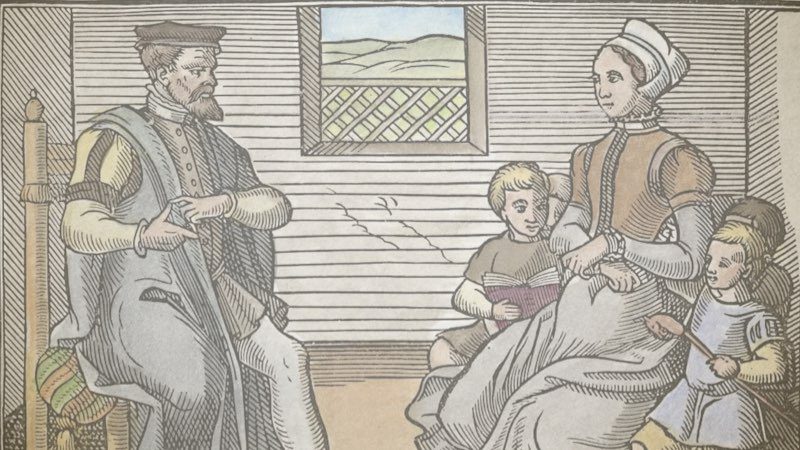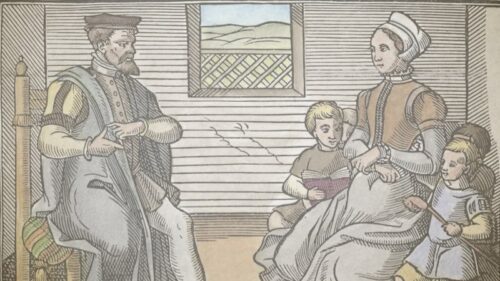
Preface
According to Bob Juch’s Kin, the Rev. James Fontaine is my great-great-great-great-great-great-grandfather. He was born in France, on the 7th April, 1658. Mr. Juch provides the following account of the life and adventures of the Rev. James Fontaine:
“Like his father, he too became a minister. His life was full of adventure. He was imprisoned for a long time, and at length escaped from France. In England he married a French lady, Anne Elizabeth Boursiquot, also a refugee. Although he was lame from a fall in childhood, yet he was active and energetic, and sued many ingenious devices to support himself and family. He received Holy orders from the Protestant Synod, assembled at Tannton. Here his first child, Mary Ann Fontaine, was born 12th April, 1690. He moved to Cork, Ireland, in 1694, and supported his family by having baizee manufactured on hand looms, for power looms had not yet come into use in England. He preached to a congregation, but they were so poor he declined to receive any compensation. On the day of a baptism of a son, he made a great supper, as though he intended to eat the wealthiest of the French reggaes in Cork; but instead of that, he invited the poor of his flock, and after they had eaten and drank abundantly of the best, he gave each a shilling to take home. Mr. Fontaine then concluded, as his family was becoming large, to find a country home, and he rented a farm on Bear Haven Bay. His plan was to eke out his income by a fishery. But here he encountered trouble entirely unexpected. One morning in June a French privateer hove in sight. She floated gently toward his house in perfect calm. She had a force of eighty men on board, besides four of his Irish neighbors who acted as guides. She mounted ten guns. He made a feint which deceived the enemy as to his numbers. The privateer entered the mouth of the creek and anchored a long musket shot from the house, presently the lieutenant landed with twenty men and marched directly toward the house, Mr. Fontaine had seven men with him in addition to his wife and children. He placed them at different windows and he posted himself in one of the towers over the door, and as the lieutenant was advancing with every appearance of confidence he fired at him with the blunderbuss loaded with large shot, some of which entered his neck and the rest his side. His men took him up, crossed the ditch and carried him to the vessel. The captain was furious at this unexpected resistance from a ministry; and sent another officer on shore with twenty more men and two small cannon, which were discharged against the house; but the position of the battery was oblique, and the balls glanced from the heavy stone walls. The conflict became a hot one. During the time there were several hundred Irishmen collected on a neighboring height, rejoicing in the anticipation of the defeat of the Fontaines. The Frenchman who was pointing the cannon was killed, and an incessant fire was kept up, and as soon as a musket was emptied it was handed down to one of the children to reload, and he was given another. Mrs. Fontaine was here and there and everywhere, carrying ammunition and giving encouragement to all, as well by what she said as by her own calm deportment. She was praying incessantly, but she took care “to keep the powder dry,” and in good supply. Claude Bonnet, a French soldier, received a ball in the fleshy part of the arm, and she applied the first dressing to it with her own hands. The engagement lasted from 8 o’clock in the morning until 4 o’clock in the afternoon, and during the whole time there had been no cessation of firing. The enemy then retired with three men killed and seven wounded. The name of James Fontaine, and his wife, too, became known throughout Europe by means of the newspapers giving the history of this defence. The government furnished him with ammunition in abundance, and he bought several six pounders which had been fished up from a wreck, and he raised a fortification and planted his guns upon it so as to command the mouth of the inlet. Mr. Fontaine then went to Dublin to wait on the Council and concert measures for the better defence of the coast. During his absence a privateer approached the house. Mrs. Fontaine was on the alert, had all the cannons loaded, and one of them fired off to show that all was in readiness for defence, and when they saw this they veered about and sailed away. Then and there the coat-of-arms of the Fontaine family ought to have been changed, and instead of the mysterious emblems known only to a herald’s office, should have been substituted the picture of a lady bravely applying the fuse to a cannon, the smoke rolling in volumes from its mouth, and the ball flying through the air in the direction of a vessel in the offing. No blood ever mingled with the Fontaines and Maurys, more noble than that of Anna Elizabeth Boursiquot. But a French privateer attacked his house for a third time, in the night, and sent eighty men in three boats on shore. Although taken by surprise, Mr. Fontaine prepared for defence. The enemy set all the outhouses on fire, and in a half hour the defender was enveloped in smoke, so that he was unable to see his enemies. He had to fire haphazard; and overloading his piece it burst and he was thrown down with such violence that three of his ribs and his collar-bone were broken, and the flesh of his right hand much torn. After he was prostrated, Mrs. Fontaine assumed the command; she had an eye to everything; she went round to furnish ammunition as it was required; and she gave courage as well by lier exhortations as her example. But such heroic efforts were of no avail and they were conquered, and Mr. Fontaine and two of his sons were carried away prisoners; the Captain announcing that he would release them on the payment of œ100. Did the lady sit down and weep? Nothing of the kind! She flew around to borrow the money. She succeeded only partly, and seeing the vessel under sail, she determined to follow by land, and keep the vessel in sight as long as she could. She ran to a promontory, and made a signal to the pirate with her apron tied to a stick. A boat was dispatched to hear what she had to say. After a great deal of bargaining the Captain agreed to release her husband upon a cash payment of œ30, and retained her son Peter as hostage for the payment of the balance of the money. Peter was subsequently released. Mr. Fontaine left this inhospitable coast, and removed to Dublin. James Fontaine and his wife had a large family of children. Of them the Rev. Peter Fontaine removed to America. He was rector of Westover parish, in Virginia, and his daughter, Mary Ann, married Isaac Winston, who had “a good fortune and a spotless reputation.” He is the ancestor of a large family of wealthy and respectable citizens of Alabama, which gave a governor to that State in the person of John Anthony Winston.(*) A daughter of James Fontaine, Mary Ann Fontaine, married Matthew Maury, in Ireland, on the 20th of October, 1716. She had been born in England, in 1690. He was of Castle Mauron, in Gascony, France. He had lived in Dublin about two years, having come hither as a refugee, on account of his religion. He was not a minister, as some have supposed; was “a very honest man, a good economist, but without property.” There is no doubt of his having been well educated, as we shall show when we come to speak of his sons. His wife (who lived until she was sixty-five) had a checkered existence. She was a girl of fourteen when she had to assist her father in defending his home against the French privateers; and, after the family came to Virginia, although the public wars with the Indians had ceased, yet the frontiers were frequently visited by their incursions, and fire, and sword, and perpetual alarms, surrounded them all the latter days of her life. The effect was to form one of the most perfect characters in the whole list of men and women belonging to her descendants (who have never been wanting in nerve or intellect). Matthew Maury and his wife came to Virginia in 1719, and settled in King William county, on the Pamunkey. They had three children–James, Mary and Abraham.”
One of Rev. Fontaine’s descendants, Ann Maury, came into possession of his original French manuscripts, detailing much of his extraordinary experiences. The manuscripts were translated into English and prepared for publication in 1838. The book was entitled, “A Tale Of The Huguenots, Or, Memoirs Of A French Refugee Family (De La Fontaine)”.
The Huguenots were French Protestants of the 16th and 17th centuries, subscribing to the teachings of John Calvin. The name “Huguenot” is of uncertain origin, but some believe it is derived from the combination of German and Flemish phrases which describes the practice of worshipping God in the home. At that time, the French Catholic Government sought to quell the Huguenots by enacting severe measures of persecution against them. Eventually, tens of thousands fled France, seeking refuge in many parts of the world, including Europe, Africa and America. Around 50,000 Huguenots migrated to England, among whom was the De La Fontaine family.
Samuel Smiles published a book in 1876 entitled, “The Huguenots: Their Settlements, Churches And Industries, In England And Ireland”. The appendix provides a list of distinguished names, including that of the De La Fontaines:
“Fontaine, De La Fontaine: many members of this family settled in England.—James Fontaine, son of James de la Fontaine, pastor of Vaux and Royan, married for his first wife an Englishwoman, a Miss Thompson, in 1628, and had by her five children;—of whom Judith, married to a M. Sinermot, was left a widow with four children. After being herself shut up in a convent, and compelled to make abjuration of her religion, she succeeded in escaping with her daughters to London, where they maintained themselves by needlework.—James, pastor of Archiac, in Saintonge, died and left a widow, who, after being confined in a dungeon for three years because of her faith, succeeded in reaching London with her three sons, one of whom became a Protestant minister in Germany.- Elizabeth, married to M. Santreau, pastor of Saujon, in Saintonge, who first emigrated to Ireland, and left it for America with his family, but their vessel being wrecked, they were all drowned within sight of Boston.— Peter, pastor of Vaux, who, after imprisonment for six months, escaped to England, and settled in London, where he became minister of the Pest House chapel. One of Peter’s daughters married John Arnauld, a London merchant.—James Fontaine married for his second wife Marie Chaillon, in 1641, by whom he had two sons and three daughters;—of whom Mary married Peter Forestier, a zealous pastor, who took refuge in London, and whose son was a celebrated chronometer maker; Ann, who married Leon Testard Sieur des Meslars, and escaped to Plymouth with her husband, but died shortly after reaching England; James (see narrative at p. 301); and Peter, who, under the influence of his wife, abjured his religion, became a Roman Catholic, and remained in France. James Fontaine, so celebrated for his exploits at Bearhaven, died in Dublin, but nearly all his family subsequently emigrated to Virginia, and settled there. His eldest daughter, Mary Anne, married Matthew Maury, of Castel Mauron, Gascony, who for a time settled in Dublin, but afterwards left for America; and from this branch the Maurys of Virginia are descended. The only one who remained in this country was Moses, who pursued the calling of an engraver, in London, in which he acquired considerable reputation. A lady in Australia writes to us as follows: “My great-great- grandfather Fontaine, or De la Fontaine, was at one time Lord of the Manor of Nismes. He was greatly persecuted for his faith. For a long time he preached to the people in the mountain gorges of the Cevennes. He ultimately escaped from France with his betrothed and his sister. After reaching London, one of his sons was employed in the Bank of England.””
I am pleased to make the autobiography of my forefather available through the online resources of the AHB. I thank the Lord Jesus Christ, who enabled us both, for that He counted us faithful, putting us into the gospel ministry.
“Now unto the King eternal, immortal, invisible, the only wise God, be honour and glory for ever and ever. Amen.”—1 Timothy 1:17
Jared Smith
James Fontaine (1658) was the great-great-great-great-great-great-grandfather of Jared Smith (Editor of the AHB). He wrote an autobiography, the material of which was compiled and published by some of his descendants. The first publication is called, ”A Tale Of The Huguenots Or Memoirs Of A French Refugee Family (De La Fontaine)” (1838). The second publication is called, “Memoirs Of A Huguenot Family” (1872).
"A Tale Of The Huguenots Or Memoirs Of A French Refugee Family (De La Fontaine)", 1838 (Complete)
Memoirs Of A Huguenot Family, 1872 (Complete)




